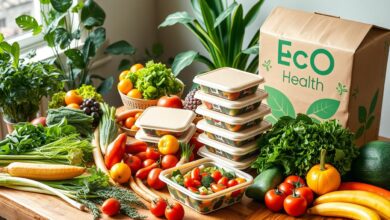Did you know that choosing seasonal produce can cut your grocery bill by up to 30%? Eating in season is more than just a trend. It’s a way to enjoy the freshest flavors and get more nutrients. Seasonal fruits and veggies add color and health to any meal.
Let’s dive into how adding seasonal produce can change our daily eating habits for the better!
Understanding the Importance of Seasonal Produce
Seasonal produce is great for our health, the planet, and our wallets. It’s like nature’s clock, guiding us to eat at the best time. This way, we get the most nutrients and taste from our food.
Nutritional Benefits
Seasonal fruits and veggies are packed with vitamins and minerals. They have more antioxidants than out-of-season ones. This is because they’re picked when they’re ripest, not stored for months.
So, eating seasonal means we get more nutrition. It’s like a natural superfood boost.
Environmental Impact
Choosing seasonal produce is also good for the planet. It needs less energy to grow and transport. This cuts down on carbon emissions and supports sustainable living.
It also helps keep our soil healthy and preserves biodiversity. It’s a win-win for nature and us.
Economic Advantages
Buying seasonal produce saves money. It’s more common and cheaper than out-of-season items. This helps our pockets and supports local farmers.
By buying local, we help our community thrive. It’s a way to make a positive impact on our economy.
| Nutritional Benefits | Environmental Impact | Economic Advantages |
|---|---|---|
| Peak in vitamins and minerals | Reduces carbon emissions | Lower costs due to abundance |
| Rich in antioxidants | Less energy for storage | Supports local farmers |
| Better flavor and texture | Conserves soil health | Strengthens local economies |
How to Identify Seasonal Produce
Knowing which fruits and veggies are in season helps us plan meals better. It ensures we eat fresh, healthy foods. We can find the best local produce by using different resources all year round.
Local Farmers’ Markets
Going to local farmers’ markets is a great way to find fresh produce. These markets have vendors who sell fruits and veggies at their peak. This gives us a real taste of the season.
We can talk to farmers and learn when certain produce is best. This makes our meals even more special.
Seasonal Guides and Apps
Using seasonal food guides and apps is another smart way to know what’s in season. These tools give detailed info on when fruits and veggies are at their best in different areas.
| App Name | Features | Availability |
|---|---|---|
| Seasonal Food Guide | Provides regional produce calendars | iOS and Android |
| Local Harvest | Locates farmers’ markets and farms | iOS and Android |
| Harvest to Hand | Features regional produce and farm events | iOS |
By using these resources, we can make better choices. We get to enjoy the health and cost benefits of eating seasonal, local produce.
Planning Our Meals Around Seasonality
One great way to add seasonal produce to your meals is to plan your meals around what’s in season. This approach brings fresh flavors to your table and makes grocery shopping easier.
Creating a Seasonal Meal Calendar
A seasonal meal calendar helps us keep track of when different fruits and veggies are at their best. This way, we can easily add them to our meals. Here’s a simple table to get you started:
| Season | Produce | Sample Meal |
|---|---|---|
| Spring | Asparagus, Strawberries, Spinach | Spring Salad with Grilled Asparagus |
| Summer | Tomatoes, Zucchini, Blueberries | Grilled Zucchini and Tomato Pasta |
| Fall | Squash, Apples, Kale | Butternut Squash Soup |
| Winter | Brussels Sprouts, Oranges, Sweet Potatoes | Roasted Brussels Sprouts and Sweet Potato Bowl |
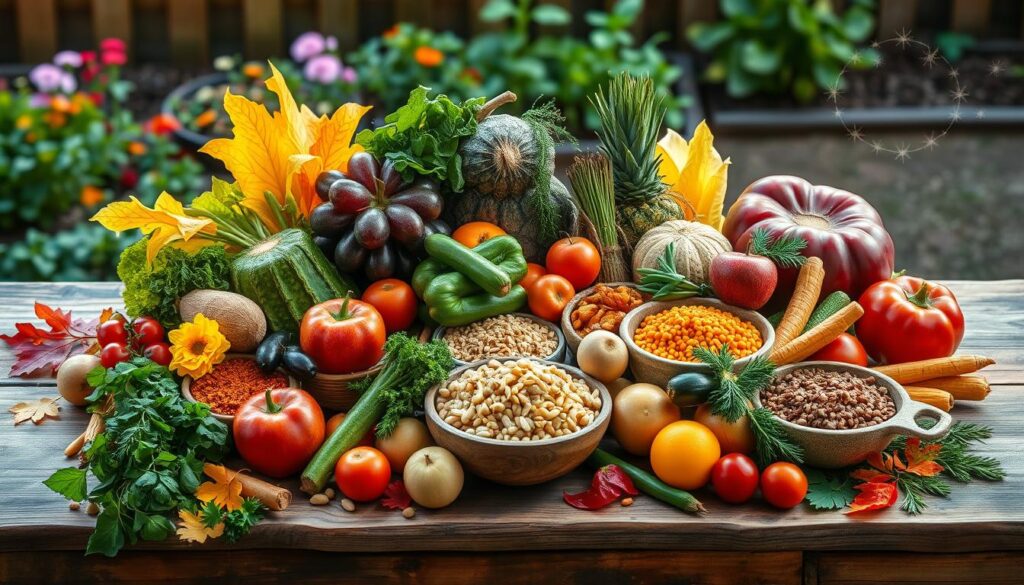
Sticking to a seasonal meal calendar lets us enjoy fresh produce all year. It also makes our diet more varied and nutritious.
Recipe Ideas for Each Season
Having a few go-to recipes for each season is helpful. Here are some ideas:
- Spring: Try light dishes like a Strawberry Spinach Salad or Asparagus Frittata.
- Summer: Enjoy the bounty with Grilled Vegetable Skewers or Berry Sorbet.
- Fall: Enjoy hearty meals like Apple and Sausage Stuffing or Pumpkin Curry.
- Winter: Warm up with Roasted Root Vegetables or a Citrus Salad.
By using these ideas, we can make sure we’re eating fresh produce all year. It’s a great way to keep our meals exciting and healthy.
Shopping Tips for Seasonal Produce
Buying the freshest produce and making smart choices at the grocery store are key for a healthy diet. Knowing the best times to shop and choosing fresh over processed foods ensures our kitchen has the best ingredients.
Best Times to Visit the Grocery Store
Timing is everything when buying the best quality fresh produce. Early mornings, right after the store opens, offer the freshest picks as stocks are newly replenished. Try to avoid shopping late in the evening when produce may have been sitting out for hours.
- Early Mornings: Freshly stocked, fewer crowds.
- Midweek Visits: Stores often restock midweek, ensuring fresh availability.
Choosing Fresh Over Processed
Choosing whole, fresh produce over processed foods is a top healthy eating tip. Processed foods often have added sugars, preservatives, and chemicals that harm a healthy diet. Eating a variety of fresh fruits and vegetables makes meals more nutritious.
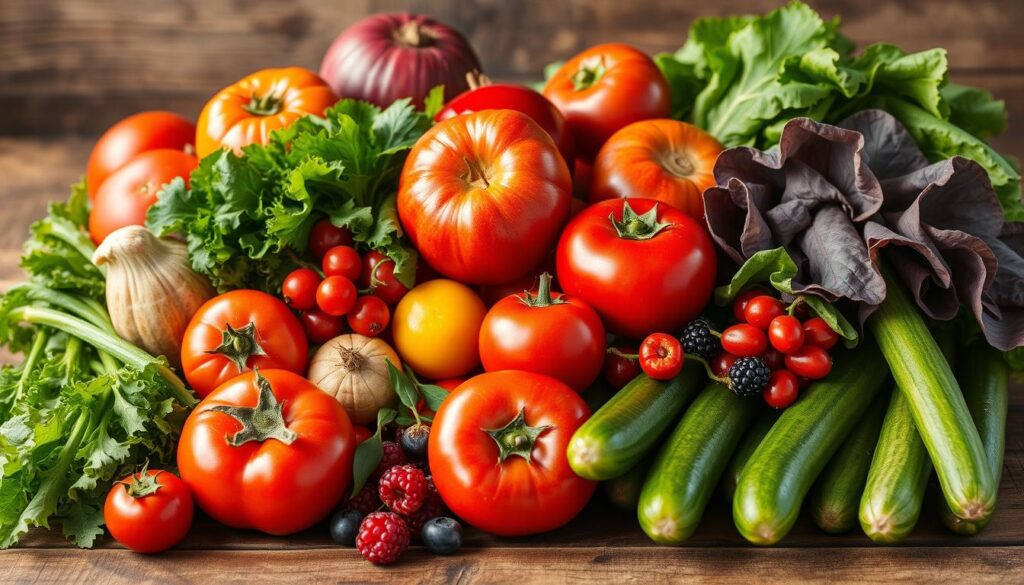
| Fresh Produce | Processed Alternatives |
|---|---|
| Whole fruits and vegetables | Canned or pre-packaged foods |
| Minimal ingredients, naturally nutrient-rich | Contains preservatives, added sugars |
Remember, adding fresh produce to our meals boosts flavors and supports our health. Making smart shopping choices can greatly improve our eating habits.
Easy Ways to Incorporate Seasonal Produce at Breakfast
Adding seasonal fruits and vegetables to our breakfasts makes meals tastier and healthier. Let’s look at some tasty healthy breakfast ideas that use fresh, in-season produce.
Smoothies and Juices
Smoothies and juices are great for adding seasonal fruits and vegetables to our diet. In summer, blend fresh berries for a bright smoothie. In spring, mix spinach and kale into a juice. Adding almond milk or coconut water makes these drinks full of nutrients.
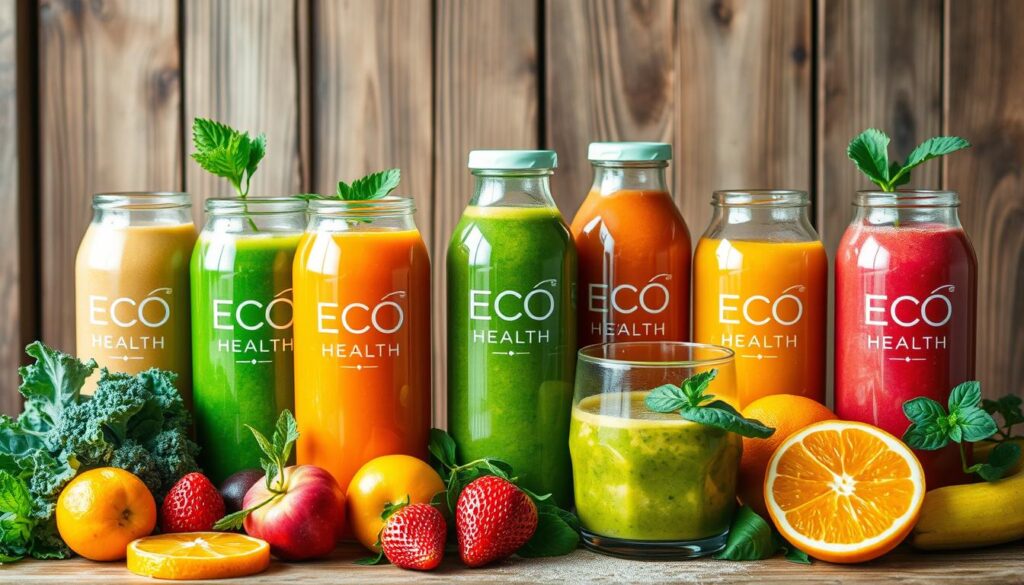
- Berry Burst Smoothie: strawberries, blueberries, and bananas blended with almond milk.
- Green Power Juice: spinach, cucumber, apple, and mint blended with a splash of lemon juice.
- Autumn Spice Smoothie: pumpkin puree, cinnamon, nutmeg, and Greek yogurt.
Breakfast Bowls and Toast
Making breakfast bowls and toast with seasonal fruits and vegetables is fun. Top oatmeal or quinoa with apples in fall or peaches in summer. For toast, avocado is always good, but try adding roasted tomatoes or radishes for a fresh twist.
| Season | Fruit Toppings | Vegetable Toppings |
|---|---|---|
| Spring | Strawberries, Kiwi | Radishes, Asparagus |
| Summer | Peaches, Berries | Tomatoes, Zucchini |
| Fall | Apples, Pears | Sweet Potatoes, Kale |
| Winter | Oranges, Pomegranates | Beets, Brussels Sprouts |
With these ideas, we can enjoy healthy breakfast ideas that are both yummy and in tune with nature’s rhythms.
Delicious Lunch Ideas Featuring Seasonal Ingredients
Using seasonal produce can make our lunches better. Fresh, vibrant ingredients add flavor and nutrition. We’ll look at two great options: salads full of fresh veggies and grain bowls with seasonal toppings.
Salads Loaded with Fresh Veggies
Salads are perfect for healthy lunches, using seasonal produce. They’re colorful, full of vitamins, and taste great. Choosing local, in-season veggies boosts flavor and nutrition. Here are some ideas:
- Spring Mix: Mix baby spinach, arugula, and radicchio with strawberries, goat cheese, and balsamic vinaigrette.
- Summer Delight: Combine cucumbers, cherry tomatoes, red onions, and sweet corn with lemon-olive oil dressing.
- Autumn Harvest: Toss kale, roasted butternut squash, dried cranberries, and pecans with maple Dijon dressing.
- Winter Wonderland: Mix Brussels sprouts, pomegranate seeds, red cabbage, and avocado with citrus vinaigrette.

Grain Bowls with Seasonal Toppings
Grain bowls are great for healthy lunches with seasonal ingredients. They’re easy to customize with different grains, proteins, and veggies. Here’s how to make tasty grain bowls:
- Spring Sensation: Start with quinoa, add asparagus, peas, radishes, and a poached egg, then drizzle with green goddess dressing.
- Summer Dream: Use brown rice, topped with grilled zucchini, bell peppers, tomatoes, and hummus.
- Autumn Feast: Begin with farro, add roasted carrots, beets, and pumpkin hummus, topped with feta cheese.
- Winter Warmth: Choose barley, add roasted root veggies, sautéed mushrooms, and tahini drizzle.
Embracing Seasonal Produce for Dinner
Using seasonal produce in our dinners is a great way to make meals healthier and tastier. It lets us enjoy vibrant roasted vegetable medleys and cozy dishes with local ingredients. This makes dinner a fun and nutritious time.
Roasted Vegetable Medleys
Roasting vegetables is a fantastic way to highlight their natural flavors. It makes them sweet and rich, perfect for any dinner. Whether it’s cold weather or summer, roasted vegetables can be a main dish or a side.
Here are some tips for making amazing roasted vegetable medleys:
- Combine different textures like crunchy carrots and creamy butternut squash for a varied taste.
- Use herbs and spices like rosemary and garlic to boost the flavors.
- Try a mix of root vegetables like sweet potatoes and beets for a hearty dish.
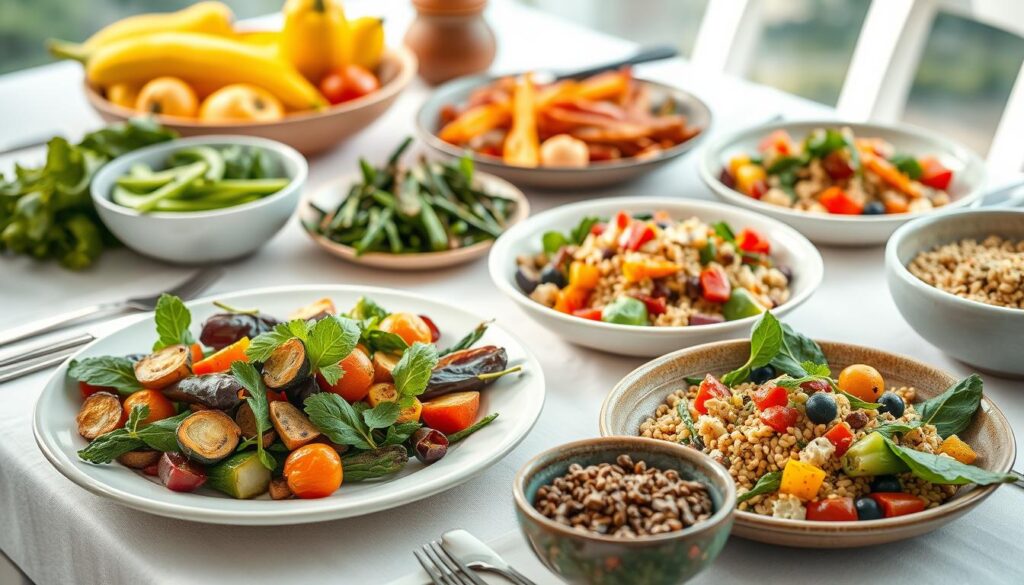
Featuring Local Meat and Produce Pairings
Pairing local meat with seasonal produce is good for farmers and our taste buds. It makes meals fresh and flavorful. Whether it’s a roast with veggies or grilled chicken with a salad, it’s a win-win.
Here are some pairing ideas for your next meal:
- Spring: Grilled lamb with asparagus and baby potatoes.
- Summer: Pan-seared fish with bell peppers, cherry tomatoes, and corn.
- Fall: Herb-roasted chicken with butternut squash, Brussels sprouts, and apples.
- Winter: Braised beef with carrots, parsnips, and caramelized onions.
By choosing healthy dinners with local ingredients, we enjoy tasty meals and help our community. It’s a win-win for everyone.
Preserving Seasonal Produce for Later Use
Preserving seasonal produce lets us enjoy our favorite fruits and veggies all year. Learn how to freeze and can to keep these fresh tastes around longer.
Freezing Techniques
Freezing is a simple and effective way to preserve seasonal produce. Follow these steps:
- Blanching: Blanch veggies in boiling water for a few minutes. This keeps their color, flavor, and nutrients.
- Cooling: Cool veggies in ice water right after blanching to stop overcooking.
- Drying: Dry the produce with a clean towel to cut down on ice crystals during freezing.
- Packing: Put the produce in freezer-safe bags or containers, getting rid of air.
Canning and Jarring
Canning and jarring is a classic way to can seasonal fruits and vegetables. It’s a bit detailed, but the outcome is great. Here’s a basic guide:
| Step | Description |
|---|---|
| Sterilizing | Clean and sterilize jars and lids to make sure they’re bacteria-free. |
| Filling | Pack fruits or veggies into jars, leaving some space at the top. |
| Sealing | Put lids on jars and screw them tight. |
| Processing | Process jars in a water bath or pressure canner to seal and preserve. |
| Cooling | Let jars cool without moving. Check seals before storing in a cool, dark spot. |
By using these methods, we can enjoy the flavors and health benefits of canning seasonal fruits and vegetables all year.
Creative Snacking with Seasonal Produce
Healthy snacking is more popular than ever. Using fresh produce recipes is a tasty and nutritious way to snack. Seasonal fruits and veggies add flavor and texture to our snacks, making them both fun and healthy. Let’s dive into some creative ways to add seasonal produce to our snacks.
Dips Made with Fresh Veggies
Fresh veggie dips are a great way to eat more produce. We can use different veggies in season to make delicious dips. For example, we can blend bell peppers, carrots, tomatoes, and zucchini into tasty dips like:
- Classic Hummus: Made with chickpeas, tahini, and lemon, with fresh garlic and herbs.
- Salsa: A mix of fresh tomatoes, onions, cilantro, and lime, perfect with veggie sticks.
- Spinach Artichoke Dip: Uses spinach and artichokes for a creamy, savory treat.
These dips are light, satisfying, and packed with vitamins and minerals. They’re great with whole-grain crackers, pita, or raw veggies.
Fruit-Based Snacks
Fruit snacks are perfect for a quick, healthy treat. Each season brings new fruits, allowing us to make tasty recipes like:
- Smoothie Popsicles: Blend berries, bananas, and almond milk, then freeze into popsicles.
- Fruit Salad: Mix watermelon, kiwi, and berries, with honey and mint.
- Baked Apple Chips: Thinly sliced apples with cinnamon, baked until crispy.
These snacks are easy, portable, and full of fruit goodness. They’re sweet, satisfying, and packed with antioxidants and fiber.
Exploring these snacking ideas lets us enjoy the flavors and health benefits of seasonal produce. Whether it’s a veggie dip or a fruit snack, there are endless ways to make snacking healthier and more fun.
Tips for Cooking with Seasonal Produce
Getting the most out of seasonal produce often depends on how we cook it. Using methods that keep flavors fresh is key. This way, we can enjoy the best of what’s in season.
Cooking Methods That Preserve Flavor
Choosing the right cooking methods is vital when working with seasonal produce. Here are some effective techniques:
- Steaming: Steaming keeps the produce’s colors, textures, and nutrients intact. It prevents overcooking.
- Roasting: Roasting enhances the natural sweetness and flavor of vegetables. It makes them caramelized and tasty.
- Sautéing: Sautéing is quick and preserves the natural flavors of vegetables. It uses a small amount of oil.
Pairing Different Seasonal Ingredients
Trying out different pairings can lead to amazing dishes. Mixing various seasonal ingredients creates dishes that are both surprising and satisfying.
For instance, combining summer tomatoes with fresh basil and mozzarella in a salad is a hit. Roasting autumn squash with thyme and cinnamon is perfect for the cold months. It offers a warm, savory-sweet taste.
Cooking with seasonal produce not only keeps flavors fresh but also boosts our creativity in the kitchen. This results in meals that are both healthy and enjoyable.
Conclusion: Benefits of Seasonal Eating
As we wrap up our look at seasonal eating, it’s key to highlight its many benefits. This lifestyle fits with nature’s rhythms and brings health, community, and environmental gains.
Enhancing Our Health and Well-being
Eating seasonally boosts our health and happiness. It means we get the most nutrients from fruits and veggies at their best. This improves digestion, strengthens our immune system, and gives us a balanced diet.
Plus, seasonal food tastes amazing and is super fresh. It makes eating more fun and fulfilling.
Supporting Local Agriculture
Seasonal eating also helps local farms thrive. Buying from farmers’ markets or CSAs keeps local farms going and boosts the local economy. It connects us with our food’s growers and cuts down on food transport’s environmental harm.
In short, seasonal eating improves our health, supports local farms, and helps the planet. By eating with the seasons, we get better food, support our community, and care for our planet.

